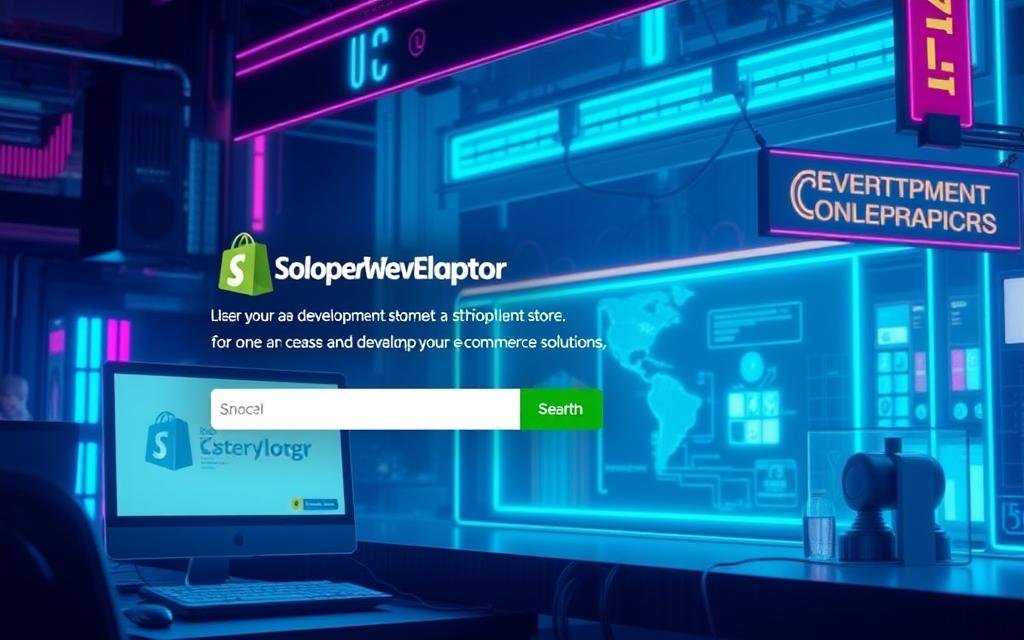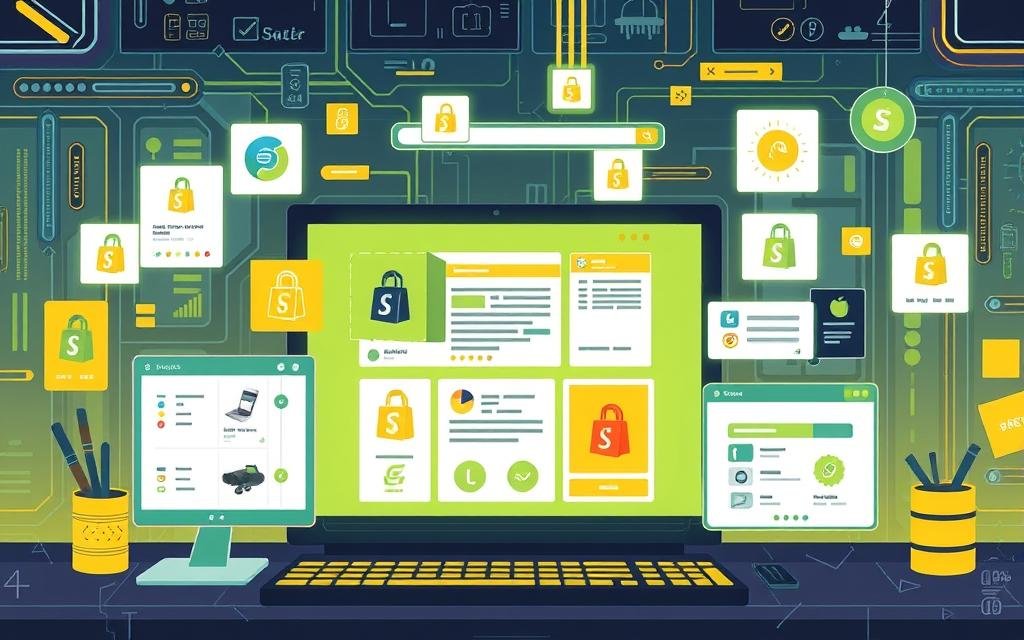Creating a successful online store requires more than just setting up a platform; it demands a comprehensive understanding of ecommerce principles, web design, and the technical aspects of shopify development.
With Shopify being one of the leading ecommerce platforms, businesses of all sizes are leveraging its potential to drive sales and growth. Proper development is key to maximizing this potential, ensuring that your store not only looks great but also converts visitors into customers.
By understanding the fundamental aspects of creating, customizing, and optimizing a Shopify store, developers and store owners can significantly enhance their online presence.
Key Takeaways
- Understand the comprehensive process of Shopify development from setup to sales.
- Learn how to maximize the potential of your online store.
- Discover the importance of professional development in creating a successful ecommerce store.
- Gain insights into the technical and design considerations for a Shopify store.
- Improve your development workflow and store performance.
Understanding Shopify Development and Its Importance
As ecommerce continues to grow, the importance of Shopify development and the expertise of Shopify developers cannot be overstated. The Shopify platform has emerged as a leading choice for businesses looking to establish a robust online presence. At the heart of this success are Shopify developers, experts who specialize in building online stores, themes, and apps using the Shopify platform.
What Is a Shopify Developer?
A Shopify developer is a professional with specialized skills in creating customized online stores, themes, and applications on the Shopify platform. They excel in frontend development, enabling merchants to express their brand identity through tailored web design and deliver unique shopping experiences for their customers. By integrating seamlessly into existing merchant workflows, Shopify developers can develop bespoke code, scripts, and apps to address complex challenges.

Why Businesses Need Shopify Development Expertise
Businesses require professional Shopify development expertise to navigate the complexities of modern ecommerce technology. Merchants must juggle multiple responsibilities, including order fulfillment, inventory management, customer service, and marketing, all while delivering an engaging customer experience. Without professional help, merchants often face challenges such as errors, bugs, compatibility issues, and difficulties with international sales.
Benefits of Professional Shopify Development
The benefits of hiring a professional Shopify developer include creating a unique brand experience, implementing advanced features, and integrating third-party services to enhance store functionality. By leveraging their expertise, businesses can improve key performance indicators such as reducing bounce rates, increasing conversion rates, and enhancing customer lifetime value through technical optimizations on the web.
In conclusion, the role of a Shopify developer is pivotal in creating successful online stores. By understanding the importance of Shopify development and leveraging the expertise of these professionals, businesses can thrive in the competitive ecommerce landscape.
Getting Started with Shopify Development
The journey to mastering Shopify development begins with a crucial first step: creating a Shopify Partner account and familiarizing oneself with the platform’s ecosystem. As a Shopify Partner, developers can create an unlimited number of development stores, which can then be transferred to clients, earning a recurring commission in the process.
Creating a Shopify Partner Account
To get started, one must create a Shopify Partner account. This involves providing basic information and verifying your identity. As a Partner, you’ll have access to development stores, which are free Shopify accounts that include most features of the Advanced Shopify plan, allowing you to test and develop stores without incurring costs.
Essential Tools for Shopify Developers
Every Shopify developer should be equipped with the right tools. Essential tools include code editors like Visual Studio Code, version control systems such as Git, and testing environments. The Shopify CLI (Command Line Interface) is also a crucial tool that streamlines the app development process, making it easier to build, test, and deploy Shopify apps efficiently.
Understanding the Shopify Architecture
Understanding the Shopify platform is vital for effective development. This includes grasping the theme structure, the Liquid templating language, and the API ecosystem. Familiarity with these components enables developers to create customized and functional stores that meet clients’ needs, leveraging the full potential of the Shopify platform.
Creating and Setting Up Development Stores
A development store is a powerful tool for Shopify developers, enabling them to test and demonstrate their work. As a Shopify Partner, you can create unlimited development stores, which are free of charge and offer most of the same functionality as the Advanced Shopify plan.

Step-by-Step Process to Create a Development Store
To create a development store, start by accessing your Shopify Partner Dashboard. From there, navigate to the “Stores” section and click on “Add store.” You’ll be prompted to enter the store’s name and other basic information. Once created, you can install and test any apps you’ve developed, display an example store for your app listing page, or set up a store for a client.
Configuring Store Settings and Preferences
After creating your development store, configuring the store settings is crucial. This involves setting up payment gateways, shipping options, and other preferences that mimic a live store environment. By doing so, you can test your apps or themes under realistic conditions, ensuring a smooth process for your clients.
Leveraging Test Data for Development
Shopify allows you to generate test data within your development stores, including demo products, sample orders, and pre-configured settings. This feature is invaluable for testing your apps and themes, as it provides a realistic environment without the need for manual data entry. You can access this feature from your store’s settings, making it easier to test and refine your work before presenting it to a client.
By following these steps and leveraging the features of development stores, you can efficiently test and showcase your Shopify apps and themes. This not only streamlines your development process but also ensures that your final product is robust and ready for launch.
Building and Customizing Your Shopify Store
Once you’ve set up your development store, the next step is to build and customize it according to your client’s needs. This involves several key processes that enhance the store’s functionality and aesthetic appeal.
Selecting and Customizing Themes
Selecting the right theme is crucial for your Shopify store’s success. You can choose from free or premium themes, depending on your client’s industry, functionality needs, and design preferences. Shopify’s theme editor allows for basic customizations, but for more advanced changes, you may need to edit the code directly. Customizing a theme can significantly improve your store’s web design and overall user experience.
Adding Products and Collections
Adding products to your Shopify store can be done individually or in bulk using a CSV file import. It’s essential to create effective product descriptions, optimize product images, and set up product variants to enhance customer engagement. Organizing products into collections improves store navigation and customer experience. This process involves creating relevant collections and assigning products to them, making it easier for customers to find what they’re looking for.
Setting Up Payment and Shipping Options
Configuring payment gateways, such as Shopify Payments and third-party providers, is vital for processing transactions smoothly. You’ll need to consider the advantages and limitations of each payment option. Additionally, setting up shipping zones, rates, and delivery methods provides customers with transparent shipping information, enhancing their overall shopping experience on your store. Effective customizing of these options is key to a successful Shopify store.
| Customization Option | Description | Benefits |
|---|---|---|
| Themes | Choose from free or premium themes to match your client’s brand | Enhances store appearance and user experience |
| Product Organization | Organize products into collections for easier navigation | Improves customer experience and store navigation |
| Payment and Shipping | Set up payment gateways and shipping options | Enhances transaction smoothness and customer satisfaction |
By focusing on these key areas, you can create a professional and functional Shopify store that meets your client’s needs and enhances their customers’ shopping experience.
Enhancing Store Functionality with Apps and Integrations

Shopify’s vast ecosystem of apps and integrations offers endless possibilities for customizing and enhancing your online store. By leveraging the right apps and integrations, you can significantly improve your store’s functionality, customer experience, and ultimately, your sales.
Essential Shopify Apps for New Stores
For new stores, selecting the right apps from the Shopify App Store is crucial. Essential apps can be categorized into marketing, sales, inventory management, customer service, and analytics. For instance, apps like Klaviyo for email marketing and various shipping apps for calculating shipping costs and duties can be invaluable. When choosing apps, consider factors such as performance impact, compatibility, support quality, and pricing models to ensure they align with your store’s needs.
Integrating Third-Party Services
Integrating third-party services is a key aspect of enhancing your store’s functionality. Services such as email marketing platforms, accounting software, and shipping solutions can be seamlessly integrated with Shopify. For example, integrating an email marketing service like Klaviyo can help automate your marketing campaigns, while shipping apps can simplify the checkout process for international customers.
Creating Custom Functionality with Private Apps
Sometimes, existing apps may not meet specific business requirements. In such cases, creating custom functionality through private apps is a viable solution. Shopify developers can build custom apps using Shopify’s API, enabling features such as authentication, data access, and webhook implementation. This approach allows for tailored solutions that perfectly fit your business needs.
It’s essential to strike a balance between adding functionality and maintaining store performance. Optimizing app usage and regularly reviewing the installed apps can help ensure that your store remains efficient and responsive.
Preparing Your Store for Client Handover
To guarantee a successful handover, follow these essential steps for your Shopify store. Transferring ownership is a critical process that requires careful preparation to ensure a smooth transition for your client.
Adding Clients as Staff Members
Before transferring ownership, add your client as a staff member and ensure they complete their staff account setup. This step is crucial as it allows your client to take control of the store gradually. Make sure your client has the necessary permissions to manage the store effectively.
Setting Up Proper Store Information
Accurate store information is vital for a successful handover. Ensure that your client’s business details, contact information, and legal policies are correctly set up in the store settings. This includes adding your client’s address to avoid any potential tax issues on their Shopify invoice.
Pre-Transfer Checklist
Use the following checklist to verify that all aspects of the store are ready for transfer:
| Task | Status |
|---|---|
| Client added as staff member | |
| Store information updated | |
| Legal policies configured |
Conclusion: From Development to Success
With the knowledge gained from this guide, you’re now equipped to tackle the complexities of Shopify development and drive ecommerce success. By following the best practices outlined, you can create a successful online store that drives sales and growth. Shopify development is an ongoing process, requiring continuous learning and adaptation to platform updates and ecommerce trends.
To further enhance your skills, explore Shopify’s official documentation, community forums, and educational content. Track key success metrics to measure the effectiveness of your development efforts. By doing so, you’ll be well on your way to creating exceptional online stores that stand out in the competitive ecommerce landscape and achieve long-term success for merchants.
